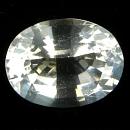|
ClassicGems.net |
|
|
 |
|
Adularia (variety of Orthoclase or Microcline) |
|
|
Discovered in 1783 IMA status: Not Valid (vaiety of Orthoclase or Microcline) |
|||
|
|
|
Chemistry |
|
|
|
|
|
KAlSi3O8 |
|
|
|
Potassium Aluminum Silicate |
|
|
|
|
More Information |
|
|
|
|
|
|
Adularia
is a variety of Orthoclase or
Microcline. |
|
Varieties: |
Barium Adularia, Moonstone, Valencianite |
|
Synonyms: |
Adulare, Alpine Orthoclase, Orthos |
|
Type Locality: |
Adula Massif, Ticino (Tessin), Switzerland |
|
Year Discovered: |
1783 |
|
View mineral photos: |
|
|
|
|
|
More Information |
|
|
|
|
|
|
Mindat.org
(Adularia) |
|
|
|
|
Adularia is a variety of Orthoclase which is is a member of the Potassium Feldspars of the Feldspar Group of minerals that includes Adularia, Albite, Amazonite, Andesine, Anorthite, Bytownite, Hyalophane, Labradorite, Moonstone, Oligoclase, Orthoclase, Sanidine and Sunstone. Adularia is generally found in "Alpine-type" formations but rarely as gem quality crystals. Although Adularia is most often known from Alpine (Alps) localities, there are a few "Alpine-type" localities in the Himalayas of Pakistan that also produce some great specimens. Most Adularia crystals are milky white and opaque to translucent. Rarely, Adularia gems are transparent or even eye clean and may show a light blue color sheen when rotated in the light. This sheen is the inspiration for the term "adularescence" which is named for the gem type. Adularia was named in 1783 by Ermenegildo Pini (1739-1825) for the type locality, the Adula Massif (part of the Gotthard massif), Switzerland. Adularia is generally found in areas of the Alps including several valleys of the Hohe Tauern Mountains, Salzburg, Austria; the Apuan Alps, Lucca Province, Tuscany, Italy; several valleys in the Alps of Switzerland. Adularia is also found in the Astore District, Northern Areas, Pakistan. |
|
Adularia gems for sale: We have not photographed our Adularia gems yet. Please check back soon. |